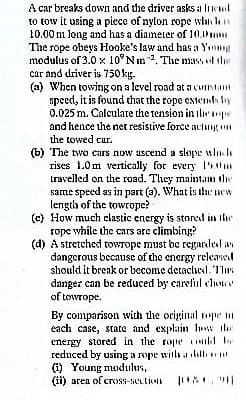A car breaks down and the driver asks a likal to tow it using a piece of nylon rope whin l 10.00 m long and has a diameter of 10.1m The rope obeys Hooke's law and has a Yin modulus of 3.0 x 10°Nm. The mas, l the car and driver is 750 ky. (a) When towing on a level road ata cuntant speed, it is found that the rope cstemth by 0.025 m. Calculate the tension in ilepe and hence the net resistive force aclug the towed cur. (b) The two cars now ascend a slope uln lh rises 1.0m vertically for every 5 travelled on the road. They maintan the same speed as in part (a). What is the new length of the towrope? (c) How much clastic energy is stored in Ihe rope while the cars are climbing? (d) A stretched towrope must be regarded av dangerous hecause of the energy released
A car breaks down and the driver asks a likal to tow it using a piece of nylon rope whin l 10.00 m long and has a diameter of 10.1m The rope obeys Hooke's law and has a Yin modulus of 3.0 x 10°Nm. The mas, l the car and driver is 750 ky. (a) When towing on a level road ata cuntant speed, it is found that the rope cstemth by 0.025 m. Calculate the tension in ilepe and hence the net resistive force aclug the towed cur. (b) The two cars now ascend a slope uln lh rises 1.0m vertically for every 5 travelled on the road. They maintan the same speed as in part (a). What is the new length of the towrope? (c) How much clastic energy is stored in Ihe rope while the cars are climbing? (d) A stretched towrope must be regarded av dangerous hecause of the energy released
University Physics Volume 1
18th Edition
ISBN:9781938168277
Author:William Moebs, Samuel J. Ling, Jeff Sanny
Publisher:William Moebs, Samuel J. Ling, Jeff Sanny
Chapter12: Static Equilibrium And Elasticity
Section: Chapter Questions
Problem 56P: Alarge uniform cylindrical steel rod of density =7.8g/cm3 is 2.0 m long and has a diameter of 5.0...
Related questions
Question
Show all working explaining detailly each step
Answer b & c

Transcribed Image Text:A car breaks down and the driver asks a likul
to tow it using a piece of nylon rope whin hs
10.00 m long and has a diameter of 10.1m
The rope obeys Hooke's law and has a Yınm
modulus of 3.0 x 10°Nm. The mass l the
car and driver is 750 kg.
(a) When towing on a level road ata cuntant
speed, it is found chat the rope cstemth by
0.025 m. Calculate the tension in iliepe
and hence the net resistive force aclug
the towed car.
(6) The two cars now ascend a slope ulnh
rises 1.0m vertically for every 50m
travelled on the road. They maintan the
same speed as in part (a). What is the new
length of the towrope?
(c) How much clastic energy is storcd in Ihr
rope while the cars are climbing?
(d) A stretched towrope must be regarded av
dangerous because of the energy released
should it brenk or become detaclied. 1lırs
danger can be reduced by careful clowe
of towrope.
By comparison with the original rope m
each case, state and explain Iw the
energy stored in the rope k be
reduced by using a rope with a lbll
(1) Young modulus,
(li) area of crooss-section
Expert Solution
This question has been solved!
Explore an expertly crafted, step-by-step solution for a thorough understanding of key concepts.
Step by step
Solved in 3 steps with 3 images

Knowledge Booster
Learn more about
Need a deep-dive on the concept behind this application? Look no further. Learn more about this topic, physics and related others by exploring similar questions and additional content below.Recommended textbooks for you

University Physics Volume 1
Physics
ISBN:
9781938168277
Author:
William Moebs, Samuel J. Ling, Jeff Sanny
Publisher:
OpenStax - Rice University

Physics for Scientists and Engineers: Foundations…
Physics
ISBN:
9781133939146
Author:
Katz, Debora M.
Publisher:
Cengage Learning

University Physics Volume 1
Physics
ISBN:
9781938168277
Author:
William Moebs, Samuel J. Ling, Jeff Sanny
Publisher:
OpenStax - Rice University

Physics for Scientists and Engineers: Foundations…
Physics
ISBN:
9781133939146
Author:
Katz, Debora M.
Publisher:
Cengage Learning